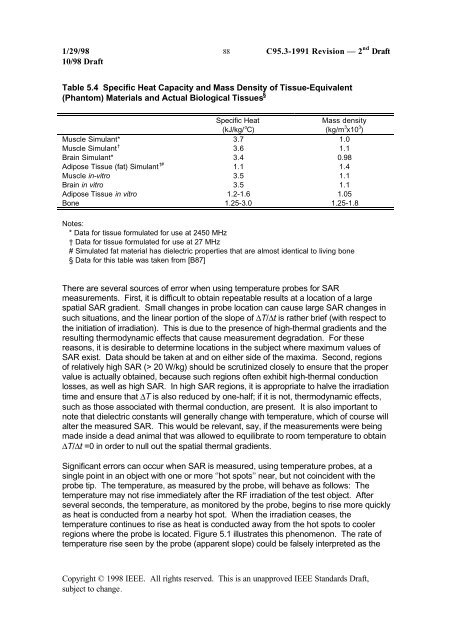DRAFT Recommended Practice for Measurements and ...
DRAFT Recommended Practice for Measurements and ...
DRAFT Recommended Practice for Measurements and ...
Create successful ePaper yourself
Turn your PDF publications into a flip-book with our unique Google optimized e-Paper software.
1/29/98 88 C95.3-1991 Revision — 2 nd Draft<br />
10/98 Draft<br />
Table 5.4 Specific Heat Capacity <strong>and</strong> Mass Density of Tissue-Equivalent<br />
(Phantom) Materials <strong>and</strong> Actual Biological Tissues §<br />
Specific Heat<br />
(kJ/kg/ o C)<br />
Mass density<br />
(kg/m 3 x10 3 )<br />
Muscle Simulant* 3.7 1.0<br />
Muscle Simulant † 3.6 1.1<br />
Brain Simulant* 3.4 0.98<br />
Adipose Tissue (fat) Simulant †# 1.1 1.4<br />
Muscle in-vitro 3.5 1.1<br />
Brain in vitro 3.5 1.1<br />
Adipose Tissue in vitro 1.2-1.6 1.05<br />
Bone 1.25-3.0 1.25-1.8<br />
Notes:<br />
* Data <strong>for</strong> tissue <strong>for</strong>mulated <strong>for</strong> use at 2450 MHz<br />
† Data <strong>for</strong> tissue <strong>for</strong>mulated <strong>for</strong> use at 27 MHz<br />
# Simulated fat material has dielectric properties that are almost identical to living bone<br />
§ Data <strong>for</strong> this table was taken from [B87]<br />
There are several sources of error when using temperature probes <strong>for</strong> SAR<br />
measurements. First, it is difficult to obtain repeatable results at a location of a large<br />
spatial SAR gradient. Small changes in probe location can cause large SAR changes in<br />
such situations, <strong>and</strong> the linear portion of the slope of ∆T/∆t is rather brief (with respect to<br />
the initiation of irradiation). This is due to the presence of high-thermal gradients <strong>and</strong> the<br />
resulting thermodynamic effects that cause measurement degradation. For these<br />
reasons, it is desirable to determine locations in the subject where maximum values of<br />
SAR exist. Data should be taken at <strong>and</strong> on either side of the maxima. Second, regions<br />
of relatively high SAR (> 20 W/kg) should be scrutinized closely to ensure that the proper<br />
value is actually obtained, because such regions often exhibit high-thermal conduction<br />
losses, as well as high SAR. In high SAR regions, it is appropriate to halve the irradiation<br />
time <strong>and</strong> ensure that ∆T is also reduced by one-half; if it is not, thermodynamic effects,<br />
such as those associated with thermal conduction, are present. It is also important to<br />
note that dielectric constants will generally change with temperature, which of course will<br />
alter the measured SAR. This would be relevant, say, if the measurements were being<br />
made inside a dead animal that was allowed to equilibrate to room temperature to obtain<br />
∆T/∆t =0 in order to null out the spatial thermal gradients.<br />
Significant errors can occur when SAR is measured, using temperature probes, at a<br />
single point in an object with one or more ‘’hot spots’’ near, but not coincident with the<br />
probe tip. The temperature, as measured by the probe, will behave as follows: The<br />
temperature may not rise immediately after the RF irradiation of the test object. After<br />
several seconds, the temperature, as monitored by the probe, begins to rise more quickly<br />
as heat is conducted from a nearby hot spot. When the irradiation ceases, the<br />
temperature continues to rise as heat is conducted away from the hot spots to cooler<br />
regions where the probe is located. Figure 5.1 illustrates this phenomenon. The rate of<br />
temperature rise seen by the probe (apparent slope) could be falsely interpreted as the<br />
Copyright © 1998 IEEE. All rights reserved. This is an unapproved IEEE St<strong>and</strong>ards Draft,<br />
subject to change.
















